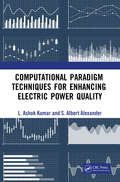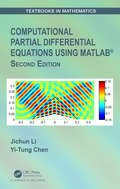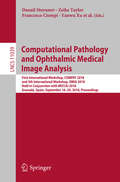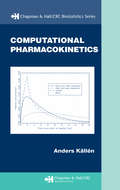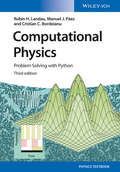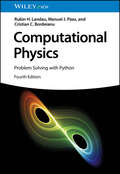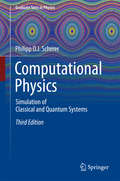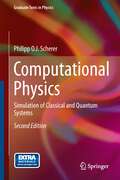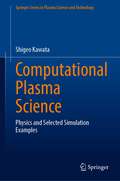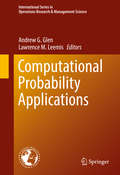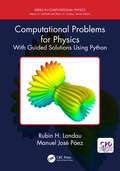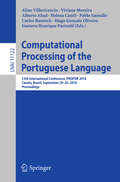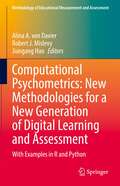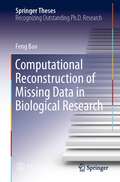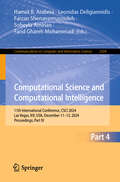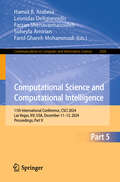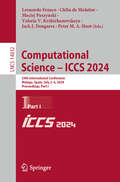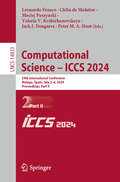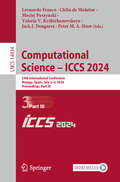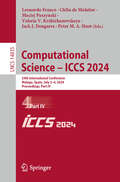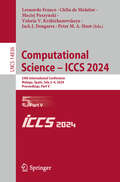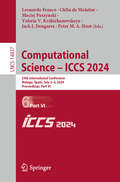- Table View
- List View
Computational Optimization: Success in Practice (Textbooks in Mathematics)
by Vladislav BukshtynovThis textbook offers a guided tutorial that reviews the theoretical fundamentals while going through the practical examples used for constructing the computational frame, applied to various real-life models. Computational Optimization: Success in Practice will lead the readers through the entire process. They will start with the simple calculus examples of fitting data and basics of optimal control methods and end up constructing a multi-component framework for running PDE-constrained optimization. This framework will be assembled piece by piece; the readers may apply this process at the levels of complexity matching their current projects or research needs. By connecting examples with the theory and discussing the proper "communication" between them, the readers will learn the process of creating a "big house." Moreover, they can use the framework exemplified in the book as the template for their research or course problems – they will know how to change the single "bricks" or add extra "floors" on top of that. This book is for students, faculty, and researchers. Features The main optimization framework builds through the course exercises and centers on MATLAB®. All other scripts to implement computations for solving optimization problems with various models use only open-source software, e.g., FreeFEM. All computational steps are platform-independent; readers may freely use Windows, macOS, or Linux systems. All scripts illustrating every step in building the optimization framework will be available to the readers online. Each chapter contains problems based on the examples provided in the text and associated scripts. The readers will not need to create the scripts from scratch, but rather modify the codes provided as a supplement to the book. This book will prove valuable to graduate students of math, computer science, engineering, and all who explore optimization techniques at different levels for educational or research purposes. It will benefit many professionals in academic and industry-related research: professors, researchers, postdoctoral fellows, and the personnel of R&D departments.
Computational Paradigm Techniques for Enhancing Electric Power Quality
by L. Ashok Kumar S Albert AlexanderThis book focusses on power quality improvement and enhancement techniques with aid of intelligent controllers and experimental results. It covers topics ranging from the fundamentals of power quality indices, mitigation methods, advanced controller design and its step by step approach, simulation of the proposed controllers for real time applications and its corresponding experimental results, performance improvement paradigms and its overall analysis, which helps readers understand power quality from its fundamental to experimental implementations. The book also covers implementation of power quality improvement practices. Key Features Provides solution for the power quality improvement with intelligent techniques Incorporated and Illustrated with simulation and experimental results Discusses renewable energy integration and multiple case studies pertaining to various loads Combines the power quality literature with power electronics based solutions Includes implementation examples, datasets, experimental and simulation procedures
Computational Partial Differential Equations Using MATLAB® (Textbooks in Mathematics)
by Jichun Li Yi-Tung ChenIn this popular text for an Numerical Analysis course, the authors introduce several major methods of solving various partial differential equations (PDEs) including elliptic, parabolic, and hyperbolic equations. It covers traditional techniques including the classic finite difference method, finite element method, and state-of-the-art numercial methods.The text uniquely emphasizes both theoretical numerical analysis and practical implementation of the algorithms in MATLAB. This new edition includes a new chapter, Finite Value Method, the presentation has been tightened, new exercises and applications are included, and the text refers now to the latest release of MATLAB. Key Selling Points: A successful textbook for an undergraduate text on numerical analysis or methods taught in mathematics and computer engineering. This course is taught in every university throughout the world with an engineering department or school. Competitive advantage broader numerical methods (including finite difference, finite element, meshless method, and finite volume method), provides the MATLAB source code for most popular PDEs with detailed explanation about the implementation and theoretical analysis. No other existing textbook in the market offers a good combination of theoretical depth and practical source codes.
Computational Pathology and Ophthalmic Medical Image Analysis: First International Workshop, COMPAY 2018, and 5th International Workshop, OMIA 2018, Held in Conjunction with MICCAI 2018, Granada, Spain, September 16 - 20, 2018, Proceedings (Lecture Notes in Computer Science #11039)
by Emanuele Trucco Lena Maier-Hein Hrvoje Bogunovic Yanwu Xu Danail Stoyanov Zeike Taylor Anne Martel Francesco Ciompi Nasir Rajpoot Jeroen van der Laak Mitko Veta Stephen McKenna David Snead Mona K. Garvin Xin Jan ChenThis book constitutes the refereed joint proceedings of the First International Workshop on Computational Pathology, COMPAY 2018, and the 5th International Workshop on Ophthalmic Medical Image Analysis, OMIA 2018, held in conjunction with the 21st International Conference on Medical Imaging and Computer-Assisted Intervention, MICCAI 2018, in Granada, Spain, in September 2018. The 19 full papers (out of 25 submissions) presented at COMPAY 2018 and the 21 full papers (out of 31 submissions) presented at OMIA 2018 were carefully reviewed and selected. The COMPAY papers focus on artificial intelligence and deep learning. The OMIA papers cover various topics in the field of ophthalmic image analysis.
Computational Pharmacokinetics
by Anders KallenBeing that pharmacokinetics (PK) is the study of how the body handles various substances, it is not surprising that PK plays an important role in the early development of new drugs. However, the clinical research community widely believes that mathematics in some way blurs the true meaning of PK. Demonstrating that quite the opposite is true, Computational Pharmacokinetics outlines the fundamental concepts and models of PK from a mathematical perspective based on clinically relevant parameters. After an introductory chapter, the book presents a noncompartmental approach to PK and discusses the numerical analysis of PK data, including a description of an absorption process through numerical deconvolution. The author then builds a simple physiological model to better understand PK volumes and compares this model to other methods. The book also introduces compartmental models, discusses their limitations, and creates a general-purpose type of model. The final chapter looks at the relationship between drug concentration and effect, known as PK/pharmacodynamics (PD) modeling.With both a solid discussion of theory and the use of practical examples, this book will enable readers to thoroughly grasp the computational factors of PK modeling.
Computational Photonics: An Introduction with MATLAB
by Marek S. WartakA comprehensive manual on the efficient modeling and analysis of photonic devices through building numerical codes, this book provides graduate students and researchers with the theoretical background and MATLAB programs necessary for them to start their own numerical experiments. Beginning by summarizing topics in optics and electromagnetism, the book discusses optical planar waveguides, linear optical fiber, the propagation of linear pulses, laser diodes, optical amplifiers, optical receivers, finite-difference time-domain method, beam propagation method and some wavelength division devices, solitons, solar cells and metamaterials. Assuming only a basic knowledge of physics and numerical methods, the book is ideal for engineers, physicists and practising scientists. It concentrates on the operating principles of optical devices, as well as the models and numerical methods used to describe them.
Computational Physics
by Cristian C. Bordeianu Rubin H. Landau Manuel J. PáezThe use of computation and simulation has become an essential part of the scientific process. Being able to transform a theory into an algorithm requires significant theoretical insight, detailed physical and mathematical understanding, and a working level of competency in programming. This upper-division text provides an unusually broad survey of the topics of modern computational physics from a multidisciplinary, computational science point of view. Its philosophy is rooted in learning by doing (assisted by many model programs), with new scientific materials as well as with the Python programming language. Python has become very popular, particularly for physics education and large scientific projects. It is probably the easiest programming language to learn for beginners, yet is also used for mainstream scientific computing, and has packages for excellent graphics and even symbolic manipulations. The text is designed for an upper-level undergraduate or beginning graduate course and provides the reader with the essential knowledge to understand computational tools and mathematical methods well enough to be successful. As part of the teaching of using computers to solve scientific problems, the reader is encouraged to work through a sample problem stated at the beginning of each chapter or unit, which involves studying the text, writing, debugging and running programs, visualizing the results, and the expressing in words what has been done and what can be concluded. Then there are exercises and problems at the end of each chapter for the reader to work on their own (with model programs given for that purpose).
Computational Physics: Problem Solving with Python
by Cristian C. Bordeianu Rubin H. Landau Manuel J. PáezThe classic in the field for more than 25 years, now with increased emphasis on data science and new chapters on quantum computing, machine learning (AI), and general relativity Computational physics combines physics, applied mathematics, and computer science in a cutting-edge multidisciplinary approach to solving realistic physical problems. It has become integral to modern physics research because of its capacity to bridge the gap between mathematical theory and real-world system behavior. Computational Physics provides the reader with the essential knowledge to understand computational tools and mathematical methods well enough to be successful. Its philosophy is rooted in “learning by doing”, assisted by many sample programs in the popular Python programming language. The first third of the book lays the fundamentals of scientific computing, including programming basics, stable algorithms for differentiation and integration, and matrix computing. The latter two-thirds of the textbook cover more advanced topics such linear and nonlinear differential equations, chaos and fractals, Fourier analysis, nonlinear dynamics, and finite difference and finite elements methods. A particular focus in on the applications of these methods for solving realistic physical problems. Readers of the fourth edition of Computational Physics will also find: An exceptionally broad range of topics, from simple matrix manipulations to intricate computations in nonlinear dynamicsA whole suite of supplementary material: Python programs, Jupyter notebooks and videos Computational Physics is ideal for students in physics, engineering, materials science, and any subjects drawing on applied physics.
Computational Physics: Simulation of Classical and Quantum Systems (Graduate Texts in Physics)
by Philipp O. J. SchererThis textbook presents basic and advanced computational physics in a very didactic style. It contains very-well-presented and simple mathematical descriptions of many of the most important algorithms used in computational physics. Many clear mathematical descriptions of important techniques in computational physics are given. The first part of the book discusses the basic numerical methods. A large number of exercises and computer experiments allows to study the properties of these methods. The second part concentrates on simulation of classical and quantum systems. It uses a rather general concept for the equation of motion which can be applied to ordinary and partial differential equations. Several classes of integration methods are discussed including not only the standard Euler and Runge Kutta method but also multistep methods and the class of Verlet methods which is introduced by studying the motion in Liouville space. Besides the classical methods, inverse interpolation is discussed, together with the popular combined methods by Dekker and Brent and a not so well known improvement by Chandrupatla. A general chapter on the numerical treatment of differential equations provides methods of finite differences, finite volumes, finite elements and boundary elements together with spectral methods and weighted residual based methods. A comparison of several methods for quantum systems is performed, containing pseudo-spectral methods, finite differences methods, rational approximation to the time evolution operator, second order differencing and split operator methods. The book gives simple but non trivial examples from a broad range of physical topics trying to give the reader insight into the numerical treatment but also the simulated problems. Rotational motion is treated in much detail to describe the motion of rigid rotors which can be just a simple spinning top or a collection of molecules or planets. The behaviour of simple quantum systems is studied thoroughly. One focus is on a two level system in an external field. Solution of the Bloch equations allows the simulation of a quantum bit and to understand elementary principles from quantum optics. As an example of a thermodynamic system, the Lennard Jones liquid is simulated. The principles of molecular dynamics are shown with practical simulations. A second thermodynamic topic is the Ising model in one and two dimensions. The solution of the Poisson Boltzman equation is discussed in detail which is very important in Biophysics as well as in semiconductor physics. Besides the standard finite element methods, also modern boundary element methods are discussed. Waves and diffusion processes are simulated. Different methods are compared with regard to their stability and efficiency. Random walk models are studied with application to basic polymer physics. Nonlinear systems are discussed in detail with application to population dynamics and reaction diffusion systems. The exercises to the book are realized as computer experiments. A large number of Java applets is provided. It can be tried out by the reader even without programming skills. The interested reader can modify the programs with the help of the freely available and platform independent programming environment "netbeans".
Computational Physics: Simulation of Classical and Quantum Systems (Graduate Texts in Physics)
by Philipp O.J. SchererThis textbook presents basic and advanced computational physics in a very didactic style. It contains very-well-presented and simple mathematical descriptions of many of the most important algorithms used in computational physics. Many clear mathematical descriptions of important techniques in computational physics are given. The first part of the book discusses the basic numerical methods. A large number of exercises and computer experiments allows to study the properties of these methods. The second part concentrates on simulation of classical and quantum systems. It uses a rather general concept for the equation of motion which can be applied to ordinary and partial differential equations. Several classes of integration methods are discussed including not only the standard Euler and Runge Kutta method but also multistep methods and the class of Verlet methods which is introduced by studying the motion in Liouville space. Besides the classical methods, inverse interpolation is discussed, together with the popular combined methods by Dekker and Brent and a not so well known improvement by Chandrupatla. A general chapter on the numerical treatment of differential equations provides methods of finite differences, finite volumes, finite elements and boundary elements together with spectral methods and weighted residual based methods. A comparison of several methods for quantum systems is performed, containing pseudo-spectral methods, finite differences methods, rational approximation to the time evolution operator, second order differencing and split operator methods.The book gives simple but non trivial examples from a broad range of physical topics trying to give the reader insight into the numerical treatment but also the simulated problems. Rotational motion is treated in much detail to describe the motion of rigid rotors which can be just a simple spinning top or a collection of molecules or planets. The behaviour of simple quantum systems is studied thoroughly. One focus is on a two level system in an external field. Solution of the Bloch equations allows the simulation of a quantum bit and to understand elementary principles from quantum optics. As an example of a thermodynamic system, the Lennard Jones liquid is simulated. The principles of molecular dynamics are shown with practical simulations. A second thermodynamic topic is the Ising model in one and two dimensions. The solution of the Poisson Boltzman equation is discussed in detail which is very important in Biophysics as well as in semiconductor physics. Besides the standard finite element methods, also modern boundary element methods are discussed. Waves and diffusion processes are simulated. Different methods are compared with regard to their stability and efficiency. Random walk models are studied with application to basic polymer physics. Nonlinear systems are discussed in detail with application to population dynamics and reaction diffusion systems. The exercises to the book are realized as computer experiments. A large number of Java applets is provided. It can be tried out by the reader even without programming skills. The interested reader can modify the programs with the help of the freely available and platform independent programming environment "netbeans".
Computational Plasma Science: Physics and Selected Simulation Examples (Springer Series in Plasma Science and Technology)
by Shigeo KawataThe book presents fundamentals of plasma physics with rich references and computational techniques in a concise manner. It particularly focuses on introductions to numerical simulation methods in plasma physics, in addition to those to physics and mathematics in plasma physics. It also presents the fundamentals of numerical methods, which solve mathematical models of plasmas, together with examples of numerical results. A discretization method, the so-called finite difference method, is introduced for particle-in-cell methods and fluid codes, which have been widely employed in plasma physics studies. In addition to the introduction to numerical solutions, it also covers numerical stability. The instabilities and numerical errors significantly influence the results, and for correct results, great efforts are required to avoid such numerical artifacts. The book also carefully discusses the numerical errors, numerical stability, and uncertainty in numerical computations. Readers are expected to have an understanding of fundamental physics of mechanics, electromagnetism, thermodynamics, statistical physics, relativity, fluid dynamics, and mathematics, but the book does not assume background knowledge on plasma. Therefore, it is a first book of plasma physics for upper undergraduate and early graduate students who are interested in learning it.
Computational Probability Applications: Algorithms And Applications In The Mathematical Sciences (International Series in Operations Research & Management Science #247)
by Andrew G. Glen Lawrence M. LeemisThis focuses on the developing field of building probability models with the power of symbolic algebra systems. The book combines the uses of symbolic algebra with probabilistic/stochastic application and highlights the applications in a variety of contexts. The research explored in each chapter is unified by the use of A Probability Programming Language (APPL) to achieve the modeling objectives. APPL, as a research tool, enables a probabilist or statistician the ability to explore new ideas, methods, and models. Furthermore, as an open-source language, it sets the foundation for future algorithms to augment the original code. Applications in Computational Probability is comprised of fifteen chapters, each presenting a specific application of computational probability using the APPL modeling and computer language. The chapter topics include using inverse gamma as a survival distribution, linear approximations of probability density functions, and also moment-ratio diagrams for univariate distributions. These works highlight interesting examples, often done by undergraduate students and graduate students that can serve as templates for future work. In addition, this book should appeal to researchers and practitioners in a range of fields including probability, statistics, engineering, finance, neuroscience, and economics.
Computational Problems for Physics: With Guided Solutions Using Python (Series in Computational Physics)
by Rubin H. Landau Manuel José PáezOur future scientists and professionals must be conversant in computational techniques. In order to facilitate integration of computer methods into existing physics courses, this textbook offers a large number of worked examples and problems with fully guided solutions in Python as well as other languages (Mathematica, Java, C, Fortran, and Maple). It’s also intended as a self-study guide for learning how to use computer methods in physics. The authors include an introductory chapter on numerical tools and indication of computational and physics difficulty level for each problem. Readers also benefit from the following features: • Detailed explanations and solutions in various coding languages. • Problems are ranked based on computational and physics difficulty. • Basics of numerical methods covered in an introductory chapter. • Programming guidance via flowcharts and pseudocode. Rubin Landau is a Distinguished Professor Emeritus in the Department of Physics at Oregon State University in Corvallis and a Fellow of the American Physical Society (Division of Computational Physics). Manuel Jose Paez-Mejia is a Professor of Physics at Universidad de Antioquia in Medellín, Colombia.
Computational Processing of the Portuguese Language: 13th International Conference, PROPOR 2018, Canela, Brazil, September 24–26, 2018, Proceedings (Lecture Notes in Computer Science #11122)
by Carlos Ramisch Aline Villavicencio Alberto Abad Viviane Moreira Helena Caseli Pablo Gamallo Hugo Gonçalo Oliveira Gustavo Henrique PaetzoldThis book constitutes the refereed proceedings of the 13th International Conference on Computational Processing of the Portuguese Language, PROPOR 2018, held in Canela, RS, Brazil, in September 2018.The 42 full papers, 3 short papers and 4 other papers presented in this volume were carefully reviewed and selected from 92 submissions. The papers are organized in topical sections named: Corpus Linguistics, Information Extraction, LanguageApplications, Language Resources, Sentiment Analysis and Opinion Mining, Speech Processing, and Syntax and Parsing.
Computational Psychometrics: With Examples in R and Python (Methodology of Educational Measurement and Assessment)
by Robert J. Mislevy Alina A. von Davier Jiangang HaoThis book defines and describes a new discipline, named “computational psychometrics,” from the perspective of new methodologies for handling complex data from digital learning and assessment. The editors and the contributing authors discuss how new technology drastically increases the possibilities for the design and administration of learning and assessment systems, and how doing so significantly increases the variety, velocity, and volume of the resulting data. Then they introduce methods and strategies to address the new challenges, ranging from evidence identification and data modeling to the assessment and prediction of learners’ performance in complex settings, as in collaborative tasks, game/simulation-based tasks, and multimodal learning and assessment tasks.Computational psychometrics has thus been defined as a blend of theory-based psychometrics and data-driven approaches from machine learning, artificial intelligence, and data science. All these together provide a better methodological framework for analysing complex data from digital learning and assessments. The term “computational” has been widely adopted by many other areas, as with computational statistics, computational linguistics, and computational economics. In those contexts, “computational” has a meaning similar to the one proposed in this book: a data-driven and algorithm-focused perspective on foundations and theoretical approaches established previously, now extended and, when necessary, reconceived. This interdisciplinarity is already a proven success in many disciplines, from personalized medicine that uses computational statistics to personalized learning that uses, well, computational psychometrics. We expect that this volume will be of interest not just within but beyond the psychometric community.In this volume, experts in psychometrics, machine learning, artificial intelligence, data science and natural language processing illustrate their work, showing how the interdisciplinary expertise of each researcher blends into a coherent methodological framework to deal with complex data from complex virtual interfaces. In the chapters focusing on methodologies, the authors use real data examples to demonstrate how to implement the new methods in practice. The corresponding programming codes in R and Python have been included as snippets in the book and are also available in fuller form in the GitHub code repository that accompanies the book.
Computational Reconstruction of Missing Data in Biological Research (Springer Theses)
by Feng BaoThe emerging biotechnologies have significantly advanced the study of biological mechanisms. However, biological data usually contain a great amount of missing information, e.g. missing features, missing labels or missing samples, which greatly limits the extensive usage of the data. In this book, we introduce different types of biological data missing scenarios and propose machine learning models to improve the data analysis, including deep recurrent neural network recovery for feature missings, robust information theoretic learning for label missings and structure-aware rebalancing for minor sample missings. Models in the book cover the fields of imbalance learning, deep learning, recurrent neural network and statistical inference, providing a wide range of references of the integration between artificial intelligence and biology. With simulated and biological datasets, we apply approaches to a variety of biological tasks, including single-cell characterization, genome-wide association studies, medical image segmentations, and quantify the performances in a number of successful metrics.The outline of this book is as follows. In Chapter 2, we introduce the statistical recovery of missing data features; in Chapter 3, we introduce the statistical recovery of missing labels; in Chapter 4, we introduce the statistical recovery of missing data sample information; finally, in Chapter 5, we summarize the full text and outlook future directions. This book can be used as references for researchers in computational biology, bioinformatics and biostatistics. Readers are expected to have basic knowledge of statistics and machine learning.
Computational Science and Computational Intelligence: 11th International Conference, CSCI 2024, Las Vegas, NV, USA, December 11–13, 2024, Proceedings, Part I (Communications in Computer and Information Science #2501)
by Hamid R. Arabnia Leonidas Deligiannidis Soheyla Amirian Farzan Shenavarmasouleh Farid Ghareh MohammadiThe CCIS book constitutes selected papers accepted in the Research Track on Artificial Intelligence of the 11th International Conference on Computational Science and Computational Intelligence, CSCI 2024, which took place in Las Vegas, NV, USA, during December 11–13, 2024. The 27 full papers included in this book were carefully reviewed and selected from a total of 383 submissions. They were organized in topical sections on large language models and methodologies; deep learning and applications; artificial intelligence and prediction methods; and artificial intelligence, machine learning, applications and alrogithms.
Computational Science and Computational Intelligence: 11th International Conference, CSCI 2024, Las Vegas, NV, USA, December 11–13, 2024, Proceedings, Part IV (Communications in Computer and Information Science #2504)
by Hamid R. Arabnia Leonidas Deligiannidis Soheyla Amirian Farzan Shenavarmasouleh Farid Ghareh MohammadiThe CCIS book constitutes selected papers accepted in the Research Track on Education of the 11th International Conference on Computational Science and Computational Intelligence, CSCI 2024, which took place in Las Vegas, NV, USA, during December 11–13, 2024. The 26 full papers included in this book were carefully reviewed and selected from a total of 155 submissions. They were organized in topical sections on subject-specific education and curriculum design; education and artificial intelligence; teaching and learning strategies and related reserach studies.
Computational Science and Computational Intelligence: 11th International Conference, CSCI 2024, Las Vegas, NV, USA, December 11–13, 2024, Proceedings, Part V (Communications in Computer and Information Science #2505)
by Hamid R. Arabnia Leonidas Deligiannidis Soheyla Amirian Farzan Shenavarmasouleh Farid Ghareh MohammadiThis CCIS book constitutes selected papers accepted in the Research Track on Smart Cities and Smart Mobility and the Research Track on Software Engineering of the 11th International Conference on Computational Science and Computational Intelligence, CSCI 2024, which took place in Las Vegas, NV, USA, during December 11–13, 2024. The Research Track on Smart Cities and Smart Mobility, CSCI-RTSC, received 75 submissions of which 15 papers were accepted. For the Research Track on Software Engineering, CSCI-RTSE, 13 papers were accepted from 58 submissions, 12 of these are included in this volume. They were organized in topical sections on Infrastructures: Smart Cities, Tools, and Utilities; Smart Cities and Smart Mobility; Software Engineering; and ongoing research projects.
Computational Science – ICCS 2024: 24th International Conference, Malaga, Spain, July 2–4, 2024, Proceedings, Part I (Lecture Notes in Computer Science #14832)
by Valeria V. Krzhizhanovskaya Jack J. Dongarra Peter M. A. Sloot Maciej Paszynski Clélia De Mulatier Leonardo FrancoThe 7-volume set LNCS 14832 – 14838 constitutes the proceedings of the 24th International Conference on Computational Science, ICCS 2024, which took place in Malaga, Spain, during July 2–4, 2024. The 155 full papers and 70 short papers included in these proceedings were carefully reviewed and selected from 430 submissions. They were organized in topical sections as follows: Part I: ICCS 2024 Main Track Full Papers; Part II: ICCS 2024 Main Track Full Papers; Part III: ICCS 2024 Main Track Short Papers; Advances in High-Performance Computational Earth Sciences: Numerical Methods, Frameworks and Applications; Artificial Intelligence and High-Performance Computing for Advanced Simulations; Part IV: Biomedical and Bioinformatics Challenges for Computer Science; Computational Health; Part V: Computational Optimization, Modelling, and Simulation; Generative AI and Large Language Models (LLMs) in Advancing Computational Medicine; Machine Learning and Data Assimilation for Dynamical Systems; Multiscale Modelling and Simulation; Part VI: Network Models and Analysis: From Foundations to Artificial Intelligence; Numerical Algorithms and Computer Arithmetic for Computational Science; Quantum Computing; Part VII: Simulations of Flow and Transport: Modeling, Algorithms and Computation; Smart Systems: Bringing Together Computer Vision, Sensor Networks, and Artificial Intelligence; Solving Problems with Uncertainties; Teaching Computational Science
Computational Science – ICCS 2024: 24th International Conference, Malaga, Spain, July 2–4, 2024, Proceedings, Part II (Lecture Notes in Computer Science #14833)
by Valeria V. Krzhizhanovskaya Jack J. Dongarra Peter M. A. Sloot Maciej Paszynski Clélia De Mulatier Leonardo FrancoThe 7-volume set LNCS 14832 – 14838 constitutes the proceedings of the 24th International Conference on Computational Science, ICCS 2024, which took place in Malaga, Spain, during July 2–4, 2024. The 155 full papers and 70 short papers included in these proceedings were carefully reviewed and selected from 430 submissions. They were organized in topical sections as follows: Part I: ICCS 2024 Main Track Full Papers; Part II: ICCS 2024 Main Track Full Papers; Part III: ICCS 2024 Main Track Short Papers; Advances in High-Performance Computational Earth Sciences: Numerical Methods, Frameworks and Applications; Artificial Intelligence and High-Performance Computing for Advanced Simulations; Part IV: Biomedical and Bioinformatics Challenges for Computer Science; Computational Health; Part V: Computational Optimization, Modelling, and Simulation; Generative AI and Large Language Models (LLMs) in Advancing Computational Medicine; Machine Learning and Data Assimilation for Dynamical Systems; Multiscale Modelling and Simulation; Part VI: Network Models and Analysis: From Foundations to Artificial Intelligence; Numerical Algorithms and Computer Arithmetic for Computational Science; Quantum Computing; Part VII: Simulations of Flow and Transport: Modeling, Algorithms and Computation; Smart Systems: Bringing Together Computer Vision, Sensor Networks, and Artificial Intelligence; Solving Problems with Uncertainties; Teaching Computational Science
Computational Science – ICCS 2024: 24th International Conference, Malaga, Spain, July 2–4, 2024, Proceedings, Part III (Lecture Notes in Computer Science #14834)
by Valeria V. Krzhizhanovskaya Jack J. Dongarra Peter M. A. Sloot Maciej Paszynski Clélia De Mulatier Leonardo FrancoThe 7-volume set LNCS 14832 – 14838 constitutes the proceedings of the 24th International Conference on Computational Science, ICCS 2024, which took place in Malaga, Spain, during July 2–4, 2024. The 155 full papers and 70 short papers included in these proceedings were carefully reviewed and selected from 430 submissions. They were organized in topical sections as follows: Part I: ICCS 2024 Main Track Full Papers; Part II: ICCS 2024 Main Track Full Papers; Part III: ICCS 2024 Main Track Short Papers; Advances in High-Performance Computational Earth Sciences: Numerical Methods, Frameworks and Applications; Artificial Intelligence and High-Performance Computing for Advanced Simulations; Part IV: Biomedical and Bioinformatics Challenges for Computer Science; Computational Health; Part V: Computational Optimization, Modelling, and Simulation; Generative AI and Large Language Models (LLMs) in Advancing Computational Medicine; Machine Learning and Data Assimilation for Dynamical Systems; Multiscale Modelling and Simulation; Part VI: Network Models and Analysis: From Foundations to Artificial Intelligence; Numerical Algorithms and Computer Arithmetic for Computational Science; Quantum Computing; Part VII: Simulations of Flow and Transport: Modeling, Algorithms and Computation; Smart Systems: Bringing Together Computer Vision, Sensor Networks, and Artificial Intelligence; Solving Problems with Uncertainties; Teaching Computational Science
Computational Science – ICCS 2024: 24th International Conference, Malaga, Spain, July 2–4, 2024, Proceedings, Part IV (Lecture Notes in Computer Science #14835)
by Valeria V. Krzhizhanovskaya Jack J. Dongarra Peter M. A. Sloot Maciej Paszynski Clélia De Mulatier Leonardo FrancoThe 7-volume set LNCS 14832 – 14838 constitutes the proceedings of the 24th International Conference on Computational Science, ICCS 2024, which took place in Malaga, Spain, during July 2–4, 2024. The 155 full papers and 70 short papers included in these proceedings were carefully reviewed and selected from 430 submissions. They were organized in topical sections as follows: Part I: ICCS 2024 Main Track Full Papers; Part II: ICCS 2024 Main Track Full Papers; Part III: ICCS 2024 Main Track Short Papers; Advances in High-Performance Computational Earth Sciences: Numerical Methods, Frameworks and Applications; Artificial Intelligence and High-Performance Computing for Advanced Simulations; Part IV: Biomedical and Bioinformatics Challenges for Computer Science; Computational Health; Part V: Computational Optimization, Modelling, and Simulation; Generative AI and Large Language Models (LLMs) in Advancing Computational Medicine; Machine Learning and Data Assimilation for Dynamical Systems; Multiscale Modelling and Simulation; Part VI: Network Models and Analysis: From Foundations to Artificial Intelligence; Numerical Algorithms and Computer Arithmetic for Computational Science; Quantum Computing; Part VII: Simulations of Flow and Transport: Modeling, Algorithms and Computation; Smart Systems: Bringing Together Computer Vision, Sensor Networks, and Artificial Intelligence; Solving Problems with Uncertainties; Teaching Computational Science
Computational Science – ICCS 2024: 24th International Conference, Malaga, Spain, July 2–4, 2024, Proceedings, Part V (Lecture Notes in Computer Science #14836)
by Valeria V. Krzhizhanovskaya Jack J. Dongarra Peter M. A. Sloot Maciej Paszynski Clélia De Mulatier Leonardo FrancoThe 7-volume set LNCS 14832 – 14838 constitutes the proceedings of the 24th International Conference on Computational Science, ICCS 2024, which took place in Malaga, Spain, during July 2–4, 2024. The 155 full papers and 70 short papers included in these proceedings were carefully reviewed and selected from 430 submissions. They were organized in topical sections as follows: Part I: ICCS 2024 Main Track Full Papers; Part II: ICCS 2024 Main Track Full Papers; Part III: ICCS 2024 Main Track Short Papers; Advances in High-Performance Computational Earth Sciences: Numerical Methods, Frameworks and Applications; Artificial Intelligence and High-Performance Computing for Advanced Simulations; Part IV: Biomedical and Bioinformatics Challenges for Computer Science; Computational Health; Part V: Computational Optimization, Modelling, and Simulation; Generative AI and Large Language Models (LLMs) in Advancing Computational Medicine; Machine Learning and Data Assimilation for Dynamical Systems; Multiscale Modelling and Simulation; Part VI: Network Models and Analysis: From Foundations to Artificial Intelligence; Numerical Algorithms and Computer Arithmetic for Computational Science; Quantum Computing; Part VII: Simulations of Flow and Transport: Modeling, Algorithms and Computation; Smart Systems: Bringing Together Computer Vision, Sensor Networks, and Artificial Intelligence; Solving Problems with Uncertainties; Teaching Computational Science
Computational Science – ICCS 2024: 24th International Conference, Malaga, Spain, July 2–4, 2024, Proceedings, Part VI (Lecture Notes in Computer Science #14837)
by Valeria V. Krzhizhanovskaya Jack J. Dongarra Peter M. A. Sloot Maciej Paszynski Clélia De Mulatier Leonardo FrancoThe 7-volume set LNCS 14832 – 14838 constitutes the proceedings of the 24th International Conference on Computational Science, ICCS 2024, which took place in Malaga, Spain, during July 2–4, 2024. The 155 full papers and 70 short papers included in these proceedings were carefully reviewed and selected from 430 submissions. They were organized in topical sections as follows: Part I: ICCS 2024 Main Track Full Papers; Part II: ICCS 2024 Main Track Full Papers; Part III: ICCS 2024 Main Track Short Papers; Advances in High-Performance Computational Earth Sciences: Numerical Methods, Frameworks and Applications; Artificial Intelligence and High-Performance Computing for Advanced Simulations; Part IV: Biomedical and Bioinformatics Challenges for Computer Science; Computational Health; Part V: Computational Optimization, Modelling, and Simulation; Generative AI and Large Language Models (LLMs) in Advancing Computational Medicine; Machine Learning and Data Assimilation for Dynamical Systems; Multiscale Modelling and Simulation; Part VI: Network Models and Analysis: From Foundations to Artificial Intelligence; Numerical Algorithms and Computer Arithmetic for Computational Science; Quantum Computing; Part VII: Simulations of Flow and Transport: Modeling, Algorithms and Computation; Smart Systems: Bringing Together Computer Vision, Sensor Networks, and Artificial Intelligence; Solving Problems with Uncertainties; Teaching Computational Science

